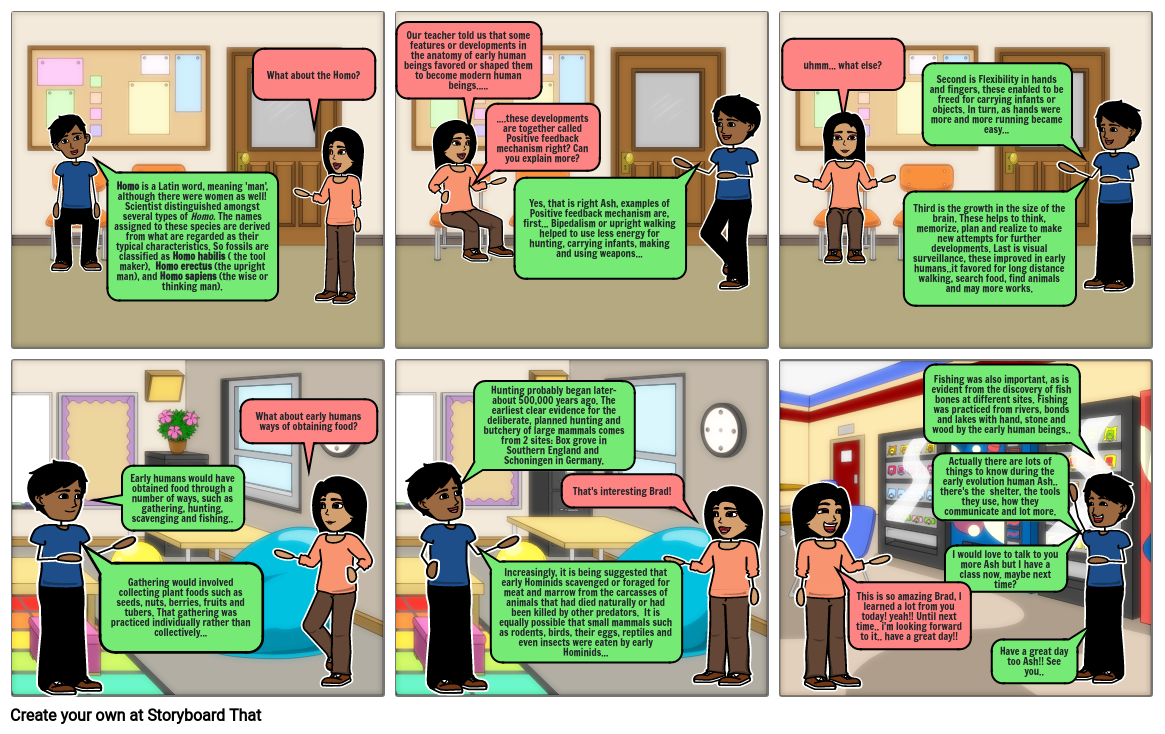Unknown Story

Texto del Guión Gráfico
- Homo is a Latin word, meaning 'man', although there were women as well! Scientist distinguished amongst several types of Homo. The names assigned to these species are derived from what are regarded as their typical characteristics. So fossils are classified as Homo habilis ( the tool maker), Homo erectus (the upright man), and Homo sapiens (the wise or thinking man).
- What about the Homo?
- Our teacher told us that some features or developments in the anatomy of early human beings favored or shaped them to become modern human beings.....
- ....these developments are together called Positive feedback mechanism right? Can you explain more?
- Yes, that is right Ash, examples of Positive feedback mechanism are, first... Bipedalism or upright walking helped to use less energy for hunting, carrying infants, making and using weapons...
- uhmm... what else?
- Third is the growth in the size of the brain. These helps to think, memorize, plan and realize to make new attempts for further developments. Last is visual surveillance, these improved in early humans..it favored for long distance walking, search food, find animals and may more works.
- Second is Flexibility in hands and fingers, these enabled to be freed for carrying infants or objects. In turn, as hands were more and more running became easy...
- Gathering would involved collecting plant foods such as seeds, nuts, berries, fruits and tubers. That gathering was practiced individually rather than collectively...
- Early humans would have obtained food through a number of ways, such as gathering, hunting, scavenging and fishing..
- What about early humans ways of obtaining food?
- Hunting probably began later- about 500,000 years ago. The earliest clear evidence for the deliberate, planned hunting and butchery of large mammals comes from 2 sites: Box grove in Southern England and Schoningen in Germany.
- Increasingly, it is being suggested that early Hominids scavenged or foraged for meat and marrow from the carcasses of animals that had died naturally or had been killed by other predators. It is equally possible that small mammals such as rodents, birds, their eggs, reptiles and even insects were eaten by early Hominids...
- That's interesting Brad!
- This is so amazing Brad, I learned a lot from you today! yeah!! Until next time.. i'm looking forward to it.. have a great day!!
- Fishing was also important, as is evident from the discovery of fish bones at different sites. Fishing was practiced from rivers, bonds and lakes with hand, stone and wood by the early human beings..
- Actually there are lots of things to know during the early evolution human Ash.. there's the shelter, the tools they use, how they communicate and lot more.
- I would love to talk to you more Ash but I have a class now. maybe next time?
- Have a great day too Ash!! See you..
Más de 30 millones de guiones gráficos creados

